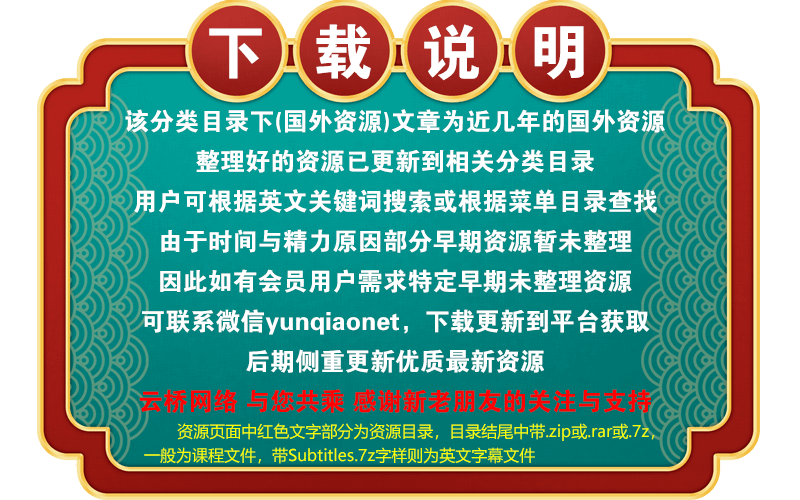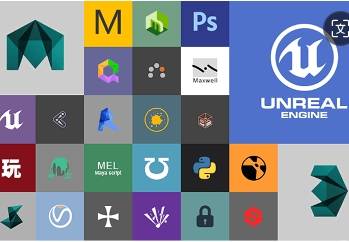Release date:2018, December
Duration:07 h 26 m
Author:Unity Coach Fred Moreau
Skill level:Beginner
Language:English
Exercise files:Yes
What Will I Learn?
Create a 3D VR project targeting a device as simple as iOS/Android cardboard.
Create immersive VR experiences with panoramic videos.
Create interactive VR game plays with advanced Unity features, including Ray Casting and NAVigation (Path Finding).
Create interactive head’s up 3D user interfaces.
Add support for Game Controllers and Cardboard “Screen Touch” button.
Take advantage of Ambisonic Audio files.
Use Unity Remote to test things in the Editor.
Bypass Unity XR SDKs and use the Gyroscope, to test things in the Editor with Unity Remote.
Take advantage of Unity’s Events to trigger actions on interactive objects, including loading scenes.
Use Unity’s Animator State Machine along with Collider Triggers, to trigger animations when passing by.Requirements
Unity 2017.3 or later.
If targeting iPhone : an Apple iOS Developer account, a Mac computer and Xcode.
If targeting Android : Android SDK (free).
As an option, if targeting iPhone : an MFI (Made For iPhone) bluetooth Game Controller.
As an option, if targeting Android : an Android bluetooth Game Controller.
If targeting Windows/Mac : a supported VR device (Oculus Rift, HTC Vive, Microsoft Hololens).Description
This course aims at helping anyone willing to learn Unity to create VR experiences.
No previous programming experience is required, and most of the principles covered in the course will help future programmers wrap their head around programming basics.
It features a self learning approach. Every topic comes in on a need to know basis.
Most of the course examples can be done with the simplest hardware.
Wether you want to experiment with a simple Android or iPhone cardboard, add a remote game controller, or go for pro hardware, the principles, techniques and code you’ll take away from this course will help you deliver a full VR experience, fast!Who is the target audience?
VR enthusiasts willing to learn Unity
Unity developers willing to learn VR featuresIntroduction 16:43
Introduction 01:53
Requirements 03:05
ROAD MAP 01:02
Project Setup & Editor Overview. 06:08
(iPhone/Android/PC/Mac) Build & Player Settings. 04:35VR Lobby 29:53
Creating and placing Game Objects. 07:29
Creating and assigning Materials. 03:03
Importing textures. 02:34
Creating and assigning a SkyBox Material. 04:13
Adding XR SDKs to use head tracking and stereo camera rendering. 02:11
(iPhone) Building and running the VR test scene on the device. 03:19
(Android) Build & Run. 06:02
(Windows/Mac) Build & Run. 01:02Adding a 360 audio/video background 10:56
Project Setup Review. 01:32
Importing Video Files. 01:37
Adding a Video Player to playback video content. 03:23
Creating a Render Texture to *link* the Video Player to the Skybox material. 04:24Adding interactivity : what am I looking/pointing at? 01:54:37
Objectives. 02:26
Scene Setup. 02:36
Using Prefabs. 07:18
Creating a new C# script and setting up our development environment. 06:23
Overview of the MonoBehaviour and C# scripting. 05:31
Accessing and modifying another component. 08:14
Using a Gradient object. 08:00
Using C# Properties to optimise the refreshing of values. 09:06
Referencing another object’s (Transform) component. 12:04
Using Code Snippets (Templates) to easily and quickly add more properties. 08:57
Using MonoDevelop Tasks. 03:38
Vectors and Visual Debug features. 12:40
More maths, with inverse linear interpolations. 05:49
Using Unity Events to drive any other value. 13:34
Using Animation Curves to ease in and out the linear interpolation. 08:21Previewing actions on interact-able items. 38:33
Object Focus Manager. 04:31
Implementing the manager as a Singleton. 09:18
Static methods. 10:59
Focus Events. 13:45Triggering actions. 32:00
Setting up the Progress Bar. 05:30
Handling touch screen inputs. 11:17
Action Trigger. 03:26
Cancelling the Trigger. 07:39
Loading a Scene. 04:08Supporting other input types. 37:28
Handling wireless gamepads. 06:07
Using Keycodes. 05:26
Using abstract classes to gather common mechanics. 17:15
Adding events to the GamePad Manager. 03:50
Using Unity’s Input class to support VR Device controllers. 04:50XR Specifics. 09:45 Recentering the sight when a scene is loaded. 09:45
Cardboard Specifics. 09:25
Using the Gyroscope instead of XR tracking when on Cardboard in the Editor.
09:00
Stereoscopic Rendering in the Editor when using the Cardboard. 00:25Navigating 3D Worlds 02:17:33
Different ways to navigate a 3D world. 02:43
Importing the basecamp scene from the Asset Store. 02:21
Scene setup. 05:57
Navigation strategy. 04:11
Looking forward… 06:40
Using Ray Casting to find an intersection. 11:18
Ignoring intersections with set layers. 04:17
Looking through trigger colliders. 02:42
Bouncing off walls.. 07:02
More Ray Casting … 06:11
Baking a NavMesh. 08:38
Finding a position within the NavMesh. 08:07
Creating a 3D reticle object. 16:34
Positioning the reticle. 06:44
Setting up the Nav Agent. 07:33
Setting up the navigation with XR devices. 08:24
Using VR “Nodes” (controllers). 00:48
Disabling XR Camera position tracking. 00:25
Opening doors as we get close. 09:43
Trigger detection. 04:12
Animator parameter change. 03:13
Filtering with tags. 02:22
Applying changes to all doors, and add a few optimisations. 07:09
Triggering Events. 00:18Video Gallery 05:45
Creating the Video Gallery UI. 01:04
Populating the UI, and adding listeners to Buttons’ onClick events. 01:22
Loading clips from Resources. 01:09
Streaming videos from Local Storage. 02:09VR Shortcuts (for Intermediate Unity developers) 04:15
How do I turn on VR (XR) support ? 00:11
How do I playback a 360 video background? 00:35
How do I default to Non VR, then switch VR on later? 00:57
How do I use VR head tracking, but disable Stereoscopic rendering? 00:14
How do I preview Head Tracking with Unity Remote? 00:31
How do I track a VR device head or hand controller? 00:19
How do I disable head tracking on the Camera? 00:21
What locations can I load or stream 360 videos from? 01:053rd parties & misc. 00:01 A few free assets worth checking out. 00:01
Upgrading to a newer version of Unity. 01:33
Upgrading the Project to Unity 2018.x 00:38
Upgrading Cinemachine to Package Manager version. 00:15
Upgrading Pro Builder to Packager Manager version. 00:30
Multi-pass VS Single Pass Rendering. 00:0801. Introduction 01. Introduction 02. Requirements 04. Project Setup & Editor Overview. 05. (iPhoneAndroidPCMac) Build & Player Settings.
02. VR Lobby 01. Creating and placing Game Objects. 02. Creating and assigning Materials. 03. Importing textures. 04. Creating and assigning a SkyBox Material. 05. Adding XR SDKs to use head tracking and stereo camera rendering. 06. (iPhone) Building and running the VR test scene on the device. 07. (Android) Build & Run. 08. (WindowsMac) Build & Run.
03. Adding a 360 audiovideo background 01. Project Setup Review. 02. Importing Video Files. 03. Adding a Video Player to playback video content. 04. Creating a Render Texture to link the Video Player to the Skybox Material.
04. Adding interactivity what am I lookingpointing at 01. Objectives. 02. Scene Setup. 03. Using Prefabs. 04. Creating a new C# script and setting up our development environment. 05. Overview of the MonoBehaviour and C# scripting. 06. Accessing and modifying another component. 07. Using a Gradient object. 08. Using C# Properties to optimise the refreshing of values. 09. Referencing another objects (Transform) component. 10. Using Code Snippets (Templates) to easily and quickly add more properties. 11. Using MonoDevelop Tasks. 12. Vectors and Visual Debug features. 13. More maths, with inverse linear interpolations. 14. Using Unity Events to drive any other value. 15. Using Animation Curves to ease in and out the linear interpolation.
05. Previewing actions on interact-able items 01. Object Focus Manager. 02. Implementing the manager as a Singleton. 03. Static methods. 04. Focus Events.
06. Triggering actions 01. Setting up the Progress Bar. 02. Handling touch screen inputs. 03. Action Trigger. 04. Cancelling the Trigger. 05. Loading a Scene.
07. Supporting other input types 01. Handling wireless gamepads. 02. Using Keycodes. 03. Using abstract classes to gather common mechanics. 04. Adding events to the GamePad Manager. 05. Using Unitys Input class to support VR Device controllers.
08. XR Specifics 01. Recentering the sight when a scene is loaded.
09. Cardboard Specifics 01. Using the Gyroscope instead of XR tracking when on Cardboard in the Editor.
10. Navigating 3D Worlds 01. Different ways to navigate a 3D world. 02. Importing the basecamp scene from the Asset Store. 03. Scene setup. 04. Navigation strategy. 05. Looking forward… 06. Using Ray Casting to find an intersection. 07. Ignoring intersections with set layers. 08. Looking through trigger colliders. 09. Bouncing off walls.. 10. More Ray Casting … 11. Baking a NavMesh. 12. Finding a position within the NavMesh. 13. Creating a 3D reticle object. 14. Positioning the reticle. 15. Setting up the Nav Agent. 16. Setting up the navigation with XR devices. 19. Opening doors as we get close. 20. Trigger detection. 21. Animator parameter change. 22. Filtering with tags. 23. Applying changes to all doors, and add a few optimisations.
Introduction to VR with Unity.7z
 Channel and
Channel and  Group
Group
1、登录后,打赏30元成为VIP会员,全站资源免费获取!
2、资源默认为百度网盘链接,请用浏览器打开输入提取码不要有多余空格,如无法获取 请联系微信 yunqiaonet 补发。
3、分卷压缩包资源 需全部下载后解压第一个压缩包即可,下载过程不要强制中断 建议用winrar解压或360解压缩软件解压!
4、云桥网络平台所发布资源仅供用户自学自用,用户需以学习为目的,按需下载,严禁批量采集搬运共享资源等行为,望知悉!!!
5、云桥网络-CG数字艺术学习与资源分享平台,感谢您的赞赏与支持!平台所收取打赏费用仅作为平台服务器租赁及人员维护资金 费用不为素材本身费用,望理解知悉!



评论(0)